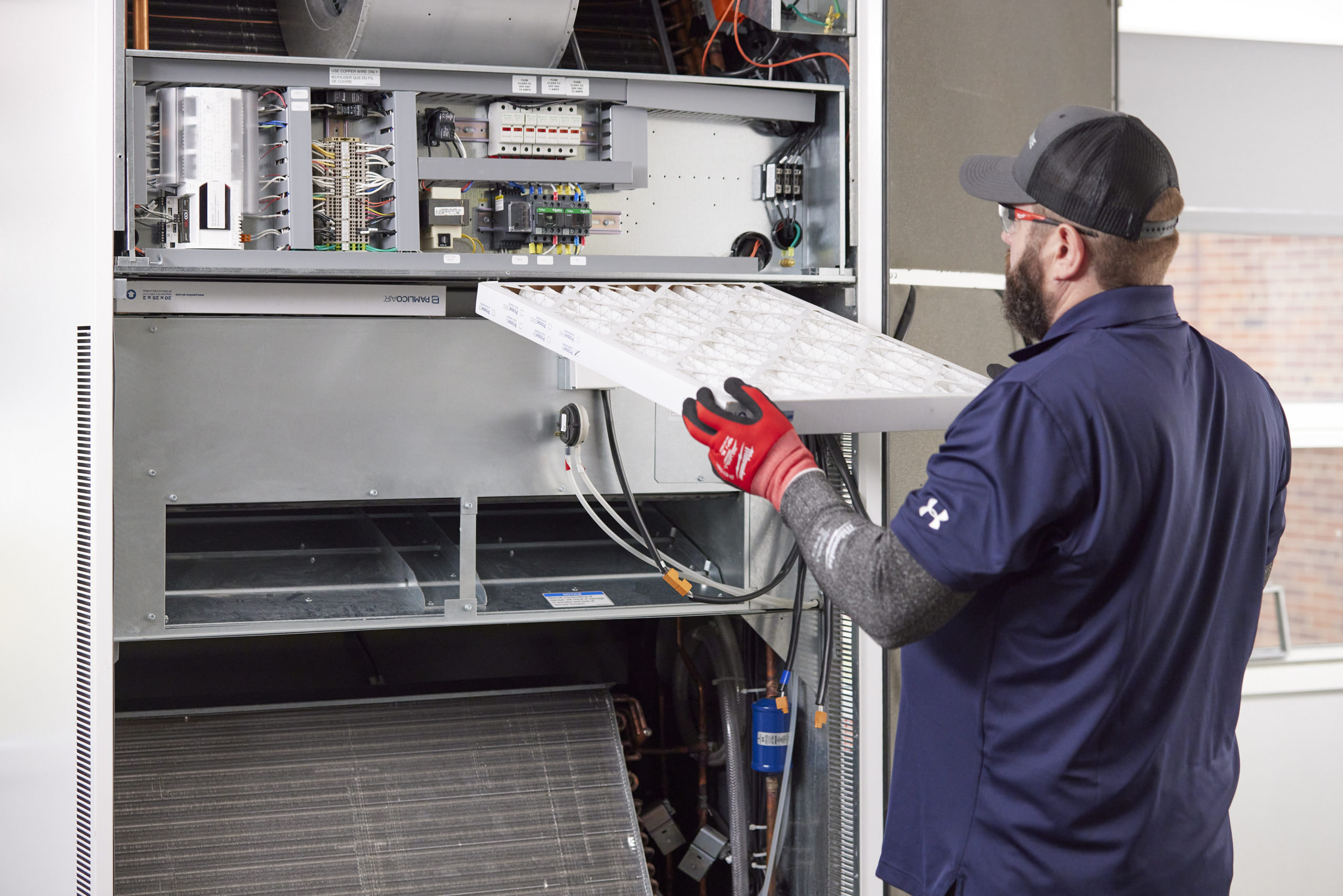Navigating O&M’s new responsibilities with Connected CMMS
Rajvel Subramanian, Facilio
Posted 04/25/2023
Revolutionizing O&M: Exploring the New Responsibilities and Opportunities of Connected CMMS
Roles in commercial real estate operations are quickly leveling up from reactive maintenance to proactive and strategic goals.
While optimizing for costs remains a priority, portfolio-wide visibility into maintenance activities, asset health, sustainability, and churn are now under their purview. Legacy CMMS solutions, however, aren’t feeling up to the challenge.

Legacy CMMS is not adequate for evolving O&M roles & responsibilities
Evolving roles in O&M would need to tie the performance evaluation metrics to both their decision-making and communications. They are in dire need of technological support that ensures all stakeholders are moving towards the same target.
Today, a CMMS should facilitate operational visibility and seamless communication for everybody–from technicians to executives.
Legacy CMMS are rarely built for end-to-end digitization and create data silos at every level.
As a result, O&M teams are forced to invest time in recurring and manual tasks instead of strategic planning. Further, many important stakeholders like vendors or your finance team are left outside the CMMS.
This lack of visibility and collaboration leaves a lot to the imagination, making property operations a jarring experience for everybody.
The Connected CMMS paradigm addresses this friction by bringing processes, stakeholders, and tools to a single space.
The new expectations from O&M teams require a more conscious approach to the tools in their armory, starting with process digitization to improve operational transparency for all stakeholders. This translates to smoother records, communication, and eliminates guesswork when it comes to data.
A Connected CMMS digitizes, centralizes, and automates processes to help you achieve outcomes like increased asset uptime, quicker response time, and lower operational or capital expenditure. Next, it provides operations leaders access to unified data from various sources via integrations, bringing internal and external stakeholders to a single platform.
This enables better visibility and reporting, enabling them to mitigate silos, pencil whipping, and erroneous data. With complete visibility into operations, executives are empowered to communicate effectively and make data-driven decisions.
Finding a strategic CMMS partner for evolving O&M teams
Strategic decision-making is led by a clear understanding of the goals you want to achieve. A connected CMMS simplifies tracking and analysis for metrics to help keep your team aligned with the wide-ranging goals of your portfolio.
Let us take a closer look at some of the metrics that O&M teams are tracking and how the Connected CMMS approach helps them optimize these for their goals:

Technicians
Technicians have to ensure that work orders are taken up and resolved to satisfaction on time. They also need visibility into whether they are working on the right asset, safety plans that can mitigate accidents, and options to keep track of their documentation. Combined, these will streamline their communication with other stakeholders, and improve operational efficiency and tenant satisfaction.
A Connected CMMS facilitates all this, plus reports for response time, SLA compliance, tenant satisfaction, vendor performance, etc.
While legacy CMMS do most of these things, their fragmented and siloed approach with a technician focus is inadequate to meet expectations from O&M teams today.
Facility Management (FM) Supervisors
Legacy CMMS don’t give enough insight into process efficiency and stakeholder satisfaction that FM supervisors need to improve operations across the portfolio.
In addition to the day-to-day operations, they are also tasked with keeping a tab on sustainability metrics, work order volume, response time, energy consumption, space utilization and efficiency, sustainable procurement, and waste reduction.
A connected CMMS centralized data and analytics for all these metrics and more, giving FM supervisors a hawk’s eye view of all the information they need in real-time.
Additionally, it enables them to be more proactive by automating recurring events like condition-based work orders, work order-wise procurement tracking, and more.
Head of property management
As a head of property management, you need to have comprehensive data around the operation of the property, but need it in formats that can be understood at a glance. The metrics you are responsible for include the occupancy rate of the property or portfolio, maintenance cost per square foot, tenant satisfaction, and turnover rate. In the connected CMMS paradigm, these data points are not only collected but presented as configurable dashboards, making them easier to navigate, analyze, and put to use.
Head of operations
As a Head of Operations, you need to ensure that your portfolio is not only meeting maintenance mandates but exceeding tenant expectations. You also need to keep an eye out for capital and operational expenditures (CapEx and OpEx). Your metrics include maintenance response time, work order completion rate, equipment downtime, energy consumption patterns and costs, and security across the portfolio.
Similar to the head of property management, you would typically need the overview of these metrics at your fingertips. The Connected CMMS paradigm helps you with intuitive and configurable dashboards, automated reporting, and integrations that bring all your stakeholders and tools together, apart from end-to-end digitized operations.
Chief Technology Officer / Chief Information Officer
As the CTO/CIO of a portfolio, you would need to ensure that the spending on technology within your organization brings in optimized returns. Your metrics include asset utilization rate, asset downtime, return on investment (ROI) on technology, and ensuring data integrity and security. With a Connected CMMS application, you get both comprehensive records and condensed dashboards of all the information around your assets, including the costs involved in their upkeep and maintenance.
Head of asset management
Heads of asset management are responsible for all things asset management within the portfolio. This includes the rate of maintenance, capital expenditure on assets, and asset lifecycle management. With Connected CMMS, you can track these metrics in real-time while having the ability to implement conditions and standards for proactive optimization. Together, these can bring down both the time spent pouring over data for problem identification and the financial leakage that comes with premature asset failure or repair.
Riding the Connected wave of smoother portfolio operations
The changing strategic roles in O&M will have a significant impact on the commercial real estate industry.
While optimizing costs remains a priority, O&M teams also need to double down on understanding asset health, portfolio-wide history and frequency of maintenance activities, insights into tenant complaints and churn among other things. Sustainability too is in focus. O&M leaders need to keep a keen eye on energy efficiency, consumption and wastage patterns, and portfolio-wide benchmarking to ensure that all is up to the mark.
Wellness metrics like internal air quality (IAQ) also need to be on the radar. Combined with metrics around occupant comfort scores, tenant request volumes, response time, and satisfaction scores, operations teams will need to have a comprehensive and strategic idea of every last element in the picture.
O&M teams will need to stay ahead of the curve by leveraging these metrics and a new approach to their CMMS to keep their edge in the environment.
With Facilio’s Connected CMMS platform, O&M teams are able to dive into these and more insights, saving them around 15 percent in manpower hours. Undeniably, this is time that they could reinvest into improving overall tenant and occupant satisfaction. But beyond the obvious, it helps the team tap into increased productivity in a sustainable fashion. With the potential it presents, the Connected CMMS approach is defining the line between operations teams that are future-ready and ones that are not.
If you haven’t already, it is high time you pick a side and get started.

Rajvel Subramanian
Raj Subramanian is part of the founding team and heads product strategy at Facilio, an AI-driven property operations platform that allows real estate owners to aggregate building data, optimize performance, and control portfolio operations – all from one place. He is passionate about using cloud technology to make operating large portfolio-wide real estate facilities across geographies easy and efficient. He is a regular speaker at various industry forums where real estate owners congregate to learn about how technology can transform their property operations and improve their bottom lines. Prior to Facilio, he led product management of the telecom & IoT product portfolio during his 10 yr stint at Zoho.
Related Articles

Uptime: Fill Out Work Orders? Who's Got Time for Paperwork?

Can Maintenance and Operations Coexist? A Radical Process Change Story

Beginning a Maintenance and Operations Partnership

What Is Facilities Management? Challenges, Solutions, & More

How a Platform Approach Can Transform Your Building Operations

3 Trends That are Set to Shape Property Ops in 2023

Install, Maintain Single-Packaged Units for Optimal IAQ




